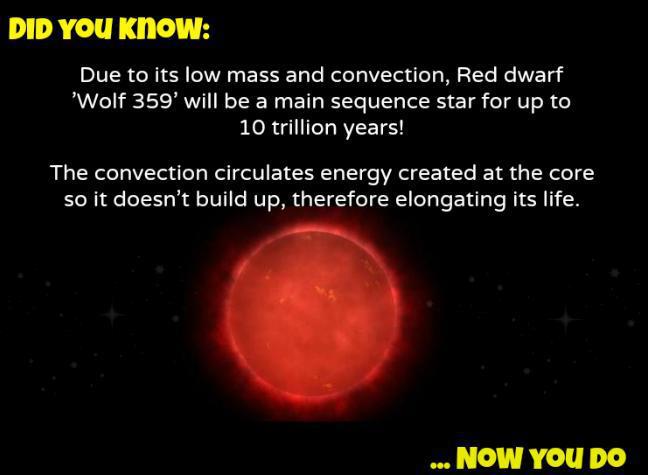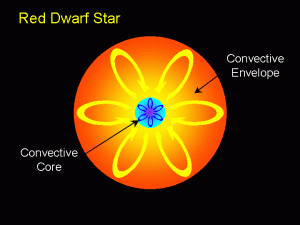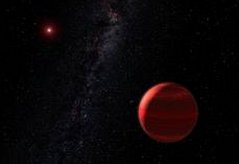

As we mentioned a few days ago, the sun was once thought to be an extraordinary star. When, in reality, the sun is merely average. The only thing that sets it apart from its counterparts is us; the fact that it is the only star known to host a planet with conscious, intelligent lifeforms. This revelation came after the discovery of the true number of red-dwarfs that are scattered about the galaxy. Stars of this type are known to be low-mass, exceptionally dim and kind of unstable – making them very difficult to see without employing special tools. But perhaps more astonishing is the fact that they can survive for trillions of years before becoming obsolete – compared to the expected ten billion year life-spans of sun-like stars.
Before going in to how this is possible; first, we must establish how the stars are classified. Astronomers categorize stars of this type by their mass – with all stars that contain about half of the total mass of the sun included. At the maximum, the mass of these stars can become about 7.5% of the sun. Any less than this and they would no longer be capable of sustaining nuclear fusion in their cores – relegating them to brown dwarf (or a “failed star”) status.
One result of their relatively small size is a decrease in energy production; with many red dwarfs only capable of generating 1/100,000th of the energy the sun produces over the course of its lifetime. This is a blessing as far as longevity is concerned. And for this, they can thank their internal system. which differs a bit from stars of other spectral types.
In our case, the sun’s core is encased in a radiative zone, which is in turn, surrounded by a convection zone. It operates by having the energy produced through nuclear fusion concentrated in the core; where it fights its way through the successive layers, before the energy is eventually emitted from the convection zone (well, technically the photosphere; but that’s another issue) – losing a substantial amount of mass in the process. The sun will only transform from main sequence mode to a red giant once it consumes the bulk of its hydrogen, resorting to fusing helium instead. After which, it will begin to balloon in size. Eventually consuming all of the planets in the inner solar system (Earth will likely be among the causalities).

Red dwarfs, on the other hand, do not have a radiative zone to speak of; thus most of the hydrogen and helium envelope is shuffled about the star’s layers – preventing the build up of material that ultimately ignites the red giant phase. This is what allows red dwarfs to remain alive for some ten trillion years. They only die after the last of their hydrogen supply for fusion is depleted – a process that can take trillions of years (exponentially longer than the current lifespan of the universe). Since none have been observed to date (it would be bad news for pretty much all of physics if they were), we are unsure of what will happen to a red dwarf after they are no longer capable of sustaining nuclear fusion, but astronomers believe they evolve into a purely hypothetical type of star, called a blue dwarf. Some of the dwarfs with a higher mass may actually turn into white dwarfs; like our sun.
The Sun’s Closest Neighbor:

One of the sun’s closest neighbors, Proxima Centauri, is actually classified as a red-dwarf. The star in question belongs to the Alpha Centauri system, which contains not one, but three stars. One of which, was recently found to have an orbiting planet.
Another red dwarf is also among the sun’s neighbors. This particular one, called Wolf 359, has less than 2/100,000th of the sun’s luminosity, with the temperature approaching 2,430 Kelvin. (Compared with the Sun’s temperature of 6,000 K). It is so dim that, if our sun were replaced by Wolf 359…we would need a telescope to make out its round shape clearly. Furthermore, daylight on Earth would be much darker than our twilight, with the brightest part of the day being only ten times brighter than the moon at perigee. (it’s closest point from Earth)
Fast Facts:
- Red Dwarfs are the most common type of star in the universe.
- Astronomers estimate that they account for 2/3rds of all stars in the Milky Way.
- Two of our closest celestial neighbors, Proxima Centauri and Wolf 359, are classified as red dwarfs.
- Our own sun is about 50% more massive than the typical red dwarf.
- Red dwarfs are also cooler and much more dim than traditional main sequence stars.
- Their internal structures differ from our own.
- Because they lack a radiative zone, they are fully convectional – allowing them to remain alive for more than a trillion – to ten trillion – years.
- Since the universe is only 13.7 billion years old, no red dwarfs have progressed from main sequence mode to a hypothetical blue dwarf.